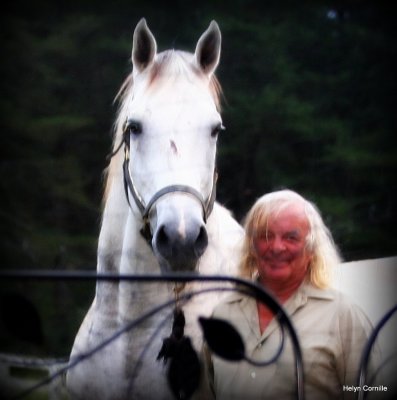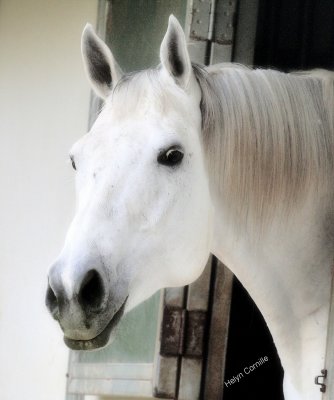Applied equine biomechanics and anatomy
Applied equine biomechanics and anatomy


Impact
“If you think globally, you are very depressed. So, the message is about acting locally. And the main message is that one of us makes some impact on the planet every single day.”
(Jane Goodall)
“Hell is empty and all the devils are here.” (William Shakespeare) A large concentration of them is in the senate. Others are bursting their ego making horses executing performances for which their physique is not athletically coordinated. They talk about art and practice abuses. The ones who learn from their horses have a chance to become a better person and impacts others around them. As human nature has surrendered to deceive and corruption, horses, and animals that humans have not exterminated yet, can teach us the values of life. One can close the minuscule circle of one’s ego finding pride in making a horse doing it. One is then truly minuscule, as horses have willingly done it for centuries, in spite of training techniques unrelated to their body function. The horses have explored beyond their natural instinct and figured, in spite of the disturbances created by the rider’s aids, use of their physique that should be part of the riders’ knowledge and the subject of the horses’ education.
“Without uncertainty, there is no creativity.” Horses had the courage to explore uncertainty and found creative use of their elastic energy. They discovered that greater use of elastic energy reduced the metabolic cost of locomotion. Only recently, science explained the horses’ discoveries. “Power absorption is therefore not always associated with eccentric contraction but can also be caused by elastic energy storage in tendons and ligaments. The subsequent power production can originate from the release of elastic energy instead of concentric muscle contraction.” (Liduin S. Meerrshoek and Anton J. van den Bogert. Mechanical Analysis of locomotion, 2003) But, instead of upgrading riding and training techniques to actual knowledge, traditional thinking ignored the phenomenon of elastic energy because it did not fit equestrian formulas.
Horses have approximatively aligned and coordinated the one hundred eighty-six synovial articulations of their vertebral column between the naïve limits of the rider inside leg and outside rein. With such limited insights from the rider, the horses never fully succeed as their nature is also protecting whatever muscle imbalance of other issues altering their body function. Their vertebral column dysfunction limited their performances and their “behavior” has been questioned. Their thoracolumbar spine dysfunction altered the kinematics of one or more limbs and they endured the pain of consequent injuries. All because riders rather believe in simplistic formulas such as the core, the string, flexing the back, the bow. Two decades after Slijper’s “bow and string” concept, Richard Tucker explained that the back muscles had the capacity to convert the thrust generated by the hind legs into horizontal forces, forward movements, and upward forces, balance control. “An initial thrust on the column is translated into a series of predominantly vertical and horizontal forces which diminish progressively as they pass from one vertebra to the next”. (Richard Tucker-1964). Tucker theory provided a much better explanation of what the horses were capable to do with the metameric structure of their thoracolumbar spine.
Uncertainty stimulates creativity. In spite of being promoted as the true, the theory of the core flexing the back had numerous holes that the horses compensated at the cost of back pain and consequent limb injuries. Tucker’s theory was uncertain but offered an explanation closer to reality than the lower line flexing the upper line. The theory deserved serious analysis, and this is when the splitting between the science of motion and tradition occurred. Tucker theory could not be applied with traditional thinking, shifts of the rider’s weight, and other beliefs. It was necessary to explore how the rider could influence the capacity of the horses’ muscular system converting the initial thrust of the hind legs into horizontal and upward forces. Tensegrity was the response, refining the dialogue with the horse into a reduced range of motion of the rider’s vertebral column and subtle nuances in muscle tone opened a conversation with the horse that classical equitation did not permit.
The subtlety of the dialogue combined with a greater understanding of the interaction of forces between the horse and the rider, leads to the realization that instead of obedience, the dialogue with the horse needed to evolve to a partnership where submission is a betrayal. The horses’ willingness is proverbial as long as the tone, the content, and the finesse of the conversation fit the horses’ natural sensitivity and refinement. Ironically, the same year that Estienne Saurel promoted shifts of the rider’s weight, “Undoubtedly any shift of the rider’s weight is important for balancing the horse for controlled movements.” (Estienne Saurel. !964. Pratique de l’ équitation d’ après les maitres français,) advancement of science started an understanding of the equine thoracolumbar function that contradicted such belief.
Breeding programs improved the quality of the horses raising equine athletic performances in general. Premier but dysfunctional athletes perform better because of their talent, but riders take the credit. The cost of dysfunction is suffering and lameness. Globally, riders accept the horses’ suffering as the price of their glory, as politicians indulge the destruction of the planet as the price of their fortune. This aspect of the equestrian industry is depressing, but locally, many open their eyes and their heart to the willingness, kindness, ethics, and creativity of the horse. In a world of fake and corruption, the horses and the animals that humans have not destroyed yet, are willing to teach us the real values of life.
Just bend the horse on a circle and instead of expecting obedience to the correct rein effect, start to think about the mechanism of the vertebral column, the complex muscular system creating the flexion, compensating for the flexion, stabilizing the flexion, and the tendons, and ligaments, and fascia. You realize then that your rein effect does not have much to do with the complex mechanism that the horse has to orchestrate bending his thoracolumbar spine. And yet, horses have coordinated their complex muscular system for centuries, compensating for our ineffectiveness.
We have today the knowledge to educate and coordinate the horses’ physique for the athletic demand of a circle or more complex performance. It is our local action. Teaching the horses how to coordinate efficiently their physique for the athletic demand of performance is respect. The horse benefit, we benefit as we learn ethics, modesty, and partnership. The planet benefits as it is not destruction for profit but respect.
Jean Luc Cornille
Learn online true equine biomechanics and in-hand dressage training


